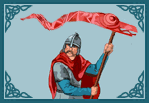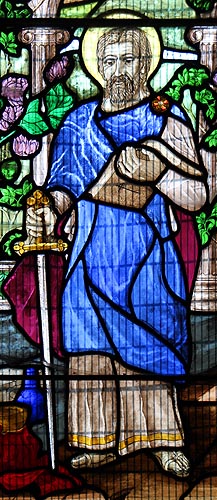 |
 |
|||
|
|
Collen was apparently the son of Pedrwn ap Coleddog ap Gwyn. His grandfather was a contemporary of King Arthur who resided at his Court and is sometimes identified with Coleddog ap Cawrdaf ap Caradog Freichfras. Collen's mother is sometimes incorrectly given as Ethni Wyddeles (the Irishwoman), but this is a transference from St. Melangell. As a young boy, Collen was sent to be educated at Orleans in Gaul (France). He remained there for eight years before returning to Britain and settling at Porth Hanwig (Southampton). During this period, the Pope was much harassed on the Continent by the warbands of a certain pagan leader from Greece named Bras. This Papal enemy had given out a challenge of single combat which he announced he was willing to fight against any champion that the Christians cared to put up against him. The prize was the adoption of the winner's religion by all the loser's followers. Eventually, the Pope was led, by Divine intervention, to seek out a champion in Porth Hanwig. Collen was the first man that his emissaries encountered and he willingly agreed to rise to the challenge. Bras and Collen met at the appointed spot and the fight began, watched by the Pope and a host of onlookers. Collen quickly found himself struck on the hand however. Bras advised him to give up, whilst magnanimously offering him a magic ointment to heal his wound. Collen accepted the gesture and mended his hand, but hurled the ointment into the river so that neither of them could benefit from its magic any more. He then threw himself into the fight in earnest and eventually managed to bring his enemy to his knees. Bras begged for mercy and agreed to the conversion of his people to Christianity. The Pope baptised him on the spot and rewarded Collen with the gift of a most holy relic: a miraculous lily which, though it had been withered, had bloomed before a crowd of pagans when they doubted the truth of the Virgin Birth (in later rears it was revered at Worcester Cathedral). Collen lived at Langolen, near Briec, in Brittany for a while, but soon returned to Britain. He landed in Kernow (Cornwall), where he settled at Colan, near Newquay. Later, he moved further east to Ynys Witrin (Glastonbury). He joined the community at the abbey there as a monk and, after only three months, was chosen as their abbot. He then took it upon himself to become something of a travelling preacher and, for three years, spent most of his time amongst the local people of Dumnonia relating the Gospel to them. He then settled at the abbey but, after another five years, grew so disillusioned by the debauchery of man that he withdrew to a small hermitage near a spring at the foot of Glastonbury Tor. It was whilst living near Glastonbury Tor that Collen heard two men talking of Gwyn ap Nudd, the King of Annwfn (the Otherworld) and of the Fairies, outside his cell. He immediately poked his head out of the door and chastised the two locals for believing in such demons. The Glastonbury men told Collen he would regret his disrespect and, not long afterwards, the saint received a visit from one of Gwyn's Royal messengers all dressed in red and blue. Three times Collen refused to meet Gwyn on top of the Tor, but eventually he became so disturbed by the messenger's demeanor that he bottled up some holy water and began to climb the great hill. At the top, he found a most magnificent castle which he had never seen before. It was garrisoned by the smartest of soldiers and everywhere there was music and song. Handsome youths rode mighty steeds around the courtyard and beautiful light-footed maidens danced between them. Collen was greeted from the ramparts and taken to see the King seated on a golden throne in his great hall. Gwyn had Collen sit beside him and invited him to dine with him, promising him the rarest of luxuries in food, wine, entertainment and courtly services. Collen was not impressed and, after a short conversation, he brought out his sprinkler and sprayed his holy water over the whole company. They disappeared in an instant and the saint was left standing alone on the hillside. That night, Collen prayed to the Lord to guide him to a safe and secluded spot where he might live out the rest of his life, away from the terrible tor. His dreams advised him to travel east (and then north) until he encountered a lone horse. This he did and, after about a hundred and fifty miles travelling through deep valleys and over high mountains, he met such a beast at a place called Rhysfa Maes Cadfarch (Llangollen in North-East Wales). The horse allowed him to mount it and he rode around the local area familiarizing himself with the landscape before settling in the centre of a great valley. Collen thought the new hermitage and chapel he had built for himself were the prefect place for prayer and contemplation, until he discovered that a flesh-eating giantess lived in a nearby mountain pass, Bwlch Rhiwfelen, and was devastating the local population. Determined to rid them of this creature, the saint took his sword up to the pass and called for the lady to appear. They only exchanged a few brief words before battle commenced. Collen quickly managed to chop off the giantess's right arm, but she picked it up and started beating him with it. So he sliced off her left arm as well. She called out for Arthur the Giant of the Eglwyseg Rocks to help her, but Collen slew her before he could hear her cries. The saint then washed his sword in St. Collen's Well on the mountainside and lived a life of peace in his Welsh valley home. St.
Collen died on 21st May, probably sometime in the early 7th century. He was
buried in his chapel. For centuries, it was known as the 'Old Church' and
stood immediately to the west of the present medieval church of St. Collen
in Llangollen. A recumbent effigy of the saint stood over his grave. Both
have now long disappeared.
Records of St. Collen date back to the 13th century but his 'life' is only 16th century. He could be historic. Click for St. Collen for Kids
|
|||
| © Nash Ford Publishing 2010. All Rights Reserved. | ||||





 St.
Collen
St.
Collen